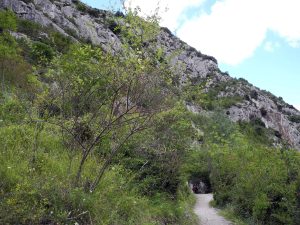
Prehistoric Artists of La Vache
The year 10 thousand BC is a little fraction of the past, quite far from us, a time we hardly know anything about when the first humans gave a tough battle for survival. A time when the only way to avoid bad weather and wild animals were to mass-shelter in caves. Dark caverns that provided basic needs made it easier to spare time for other efforts, perhaps unwittingly taking humans under their wings like the safe and warm arms of a mother’s womb.
Humans reflected the effects of a life constantly on alert through paintings they made on stones, walls, bones and other materials that disappeared in time, with an effort to give meaning to a world much of which was an unknown. The foothills of the Pyrenees in France are adorned with caves filled with the works of the first artists who lived in Europe during the Magdalenian Period, the last section of the Upper Palaeolithic, some 15,000-10,000 years ago.

La Vache Cave or Grotte de la Vache is a complete settlement area exhibiting the life of hunter-gatherers of the time with weapons, games, various tools and artworks. It is an important place with an enormous entrance of 55 metres high and 50 metres wide, with chambers longer than two kilometres, hosting more than a hundred wall paintings in very good condition from the Magdalenian Period.
It is also the home of artists that worked on the artifacts adorning Grotte de Niaux, another cave across the same valley. Paintings depicting game animals, predators, humans, and various rituals adorn the walls, stones, bones, and other materials. Some have an artistic value far beyond the primitive images engraved in our minds as “cave paintings”. A picture of a lion engraved on a bone in La Vache Cave is surprisingly realistic, and interestingly symbolic.
Solitary living and quite large cave lions without manes have long been extinct. Since these cave lions hunted deer, buffaloes, wolves, hyenas, and even bears, sharing the habitats and food sources with humans, they were probably a threat to Neanderthals and modern humans. This tremendous predator of the Ice Age thought to possess supernatural powers, both spread terror and was regarded as a symbol of nobility and power by humans who portrayed their respect in every opportunity.
This frieze of lions, embroidered on an animal bone, has a “happy” expression as well as realistic body movements. In addition, it was pictured in different positions in a series to give the feeling that it is running. It is an artistic development commonly encountered in artifacts from this period.
The Frieze of Lions, along with the other objects found in the same cave, is now on display at the National Archaeological Museum in Paris.
REFERENCES
- 1. https://www.atlasobscura.com/places/frieze-of-lions-national-archaeology-museum?utm_source=Atlas+Obscura+Daily+Newsletter&utm_campaign=ca75be1f34-EMAIL_CAMPAIGN_2019_05_13&utm_medium=email&utm_term=0_f36db9c480-ca75be1f34-69884689&ct=t(EMAIL_CAMPAIGN_05_13_2019)&mc_cid=ca75be1f34&mc_eid=8a03e582e7
- 2. https://journals.openedition.org/palethnologie/861?lang=en
- 3. https://www.donsmaps.com/grottevache.html
